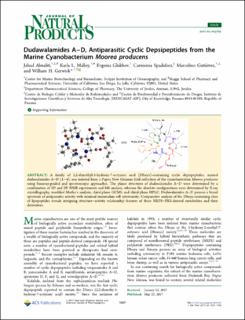Dudawalamides A−D, Antiparasitic Cyclic Depsipeptides from the Marine Cyanobacterium Moorea producens
Fecha
2017-05-23Autor
Almaliti, Jehad
Malloy, Karla L.
Glukhov, Evgenia
Spadafora, Carmenza
Gutierrez, Marcelino
Gerwick, William H.
Metadatos
Mostrar el registro completo del ítemResumen
HPLC. DudA family of 2,2-dimethyl-3-hydroxy-7-octynoic acid (Dhoya)-containing cyclic depsipeptides, named dudawalamides A−D (1−4), was isolated from a Papua New Guinean field collection of the cyanobacterium Moorea producens using bioassay-guided and spectroscopic approaches. The planar structures of dudawalamides A−D were determined by a combination of 1D and 2D NMR experiments and MS analysis, whereas the absolute configurations were determined by X-ray crystallography, modified Marfey’s analysis, chiral-phase GCMS, and chiral-phase awalamides A−D possess a broad spectrum of antiparasitic activity with minimal mammalian cell cytotoxicity. Comparative analysis of the Dhoya-containing class of lipopeptides reveals intriguing structure−activity relationship features of these NRPS−PKS-derived metabolites and their derivatives.

